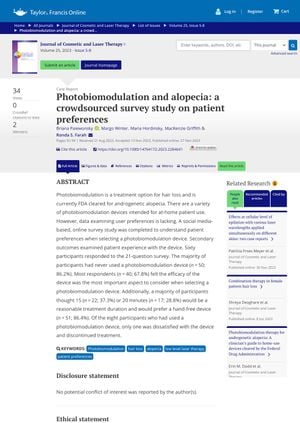TLDR Most alopecia patients are open to trying light therapy, especially at-home devices, but cost is a big factor in their willingness.
The study "Photobiomodulation and alopecia: a crowdsourced survey study on patient preferences" conducted by the University of Minnesota Department of Dermatology and other institutions, surveyed patients with alopecia to understand their preferences regarding photobiomodulation (PBM) treatment. The study found that a majority of the patients were willing to try PBM as a treatment option for alopecia. However, the willingness to try PBM was significantly influenced by the cost of the treatment, with a higher cost leading to less willingness. The study also found that patients preferred at-home PBM devices over in-clinic devices due to the convenience factor. The study did not mention the exact number of participants.
 34 citations
,
September 2019 in “Clinical, Cosmetic and Investigational Dermatology”
34 citations
,
September 2019 in “Clinical, Cosmetic and Investigational Dermatology” Light therapy can stimulate hair growth and is more effective when started early, but more research is needed on its long-term effects and optimal use.
 520 citations
,
January 2017 in “AIMS biophysics”
520 citations
,
January 2017 in “AIMS biophysics” Photobiomodulation therapy using red and near-infrared light can reduce inflammation and aid in healing various conditions.
 60 citations
,
December 2015 in “Lasers in Medical Science”
60 citations
,
December 2015 in “Lasers in Medical Science” Low-level laser therapy is safe and can increase hair growth for male and female pattern hair loss.
 160 citations
,
January 2009 in “Clinical Drug Investigation”
160 citations
,
January 2009 in “Clinical Drug Investigation” HairMax LaserComb® effectively promotes hair growth and stops hair loss in males with androgenetic alopecia, with no serious side effects.
 1 citations
,
January 2018 in “Springer eBooks”
1 citations
,
January 2018 in “Springer eBooks” Photobiomodulation is an effective and safe treatment for increasing hair growth in people with hair loss.
 1 citations
,
October 2022 in “Sci”
1 citations
,
October 2022 in “Sci” Helmets used in acupuncture and light therapy can affect brain blood flow, hair growth, and may improve brain diseases and cognitive functions.
 December 2025 in “Medical Sciences”
December 2025 in “Medical Sciences” Regenerative therapies show promise for hair regrowth, but more research and standardization are needed.
 36 citations
,
April 2016 in “Experimental Dermatology”
36 citations
,
April 2016 in “Experimental Dermatology” Photobiomodulation may help with hair growth and wound healing, but research is inconsistent and needs better quality studies.
26 citations
,
December 2020 in “Photodermatology Photoimmunology & Photomedicine” Photobiomodulation can improve hair density and thickness, but it's costly and needs more research.








